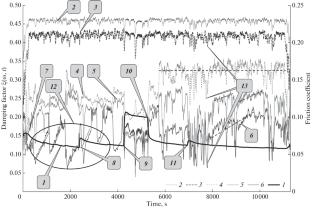Elastic-Dissipative Properties of Heavy-Loaded Modified Friction Pairs
Abstract—
Attempts to solve interrelated tasks by specifying materials for coatings and developing a methodology for monitoring the friction unit operation have been tried previously. The importance and originality of this study is that it examines the distribution of elements in the CrAlSiN coating, as well as their comparative physical, mechanical, and tribological properties. Besides, we have found that surface modification with a coating of the CrAlSiN system increases the strength and resistance to plastic deformation, which ensures high-quality deposition of thin vacuum ion-plasma coatings and leads to an increase in wear resistance. To control friction units with such coatings, it was decided to develop a monitoring technology using a dimensionless damping coefficient of friction-mechanical bonds in sub-octave band frequency ranges of forced vibrations. It makes it possible to identify natural vibration frequencies, which manifest the properties of the coatings and modifiers used for friction or anti-friction purposes. Our findings should make a significant contribution to tribology. Alongside observations of variations in the elastic-dissipative and inertial properties of the interaction between contact surfaces, the analysis of the generalized dynamic criteria on heavily loaded friction units that operate in the boundary lubrication mode allowed determining adhesion stability of contact friction bodies for friction subsystems. Furthermore, we have defined the effectiveness of lubricants, transition to boundary friction, and non-lubricated friction for antifriction subsystems. The use of the technologies developed by the authors for heavy-loaded tribosystems makes it possible to increase the wear resistance, reliability, and safety of operation of railway and air transport.


 求助内容:
求助内容: 应助结果提醒方式:
应助结果提醒方式:


